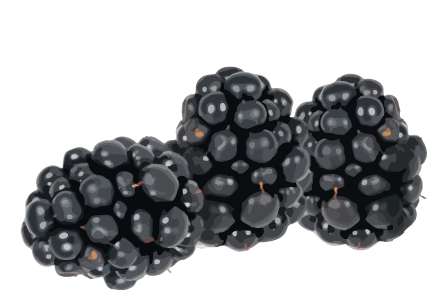Eat Smart, Move More at Farmers Markets: Blackberries
ID
HNFE-320-12NP

Key Points
- Excellent source of vitamins C and K and a good source of fiber. Contain carotenoids andflavonoids that may be good for health.
- Choose blackberries that are shiny and not bruised or leaking.
- Wash hands with warm water and soap for at least 20 seconds before and after handling fresh fruits and vegetables.
- Refrigerate blackberries for three to six days; wash just before using.
Blackberry Breakfast Bars
Number of servings: 20
Ingredients:
2 cups fresh or frozen blackberries
2 tablespoons granulated sugar
2 tablespoons water
1 tablespoon lemon juice
3/4 teaspoon ground cinnamon, divided
1 cup all-purpose flour
1 cup quick-cooking rolled oats
2/3 cup brown sugar, packed
1/8 teaspoon baking soda
1/2 cup butter, melted
Directions:
- Heat oven to 350°F.
- In a medium saucepan, combine berries, sugar, water, juice, and 1/2 teaspoon cinnamon. Bring to a boil, then reduce heat and simmer uncovered for 8 minutes, stirring frequently. Remove from heat. Set aside.
- In a medium mixing bowl, stir together flour, oats, brown sugar, 1/4 teaspoon cinnamon, and baking soda. Stir in melted butter until thoroughly combined.
- Set aside 1 cup of the oats mixture for topping.
- Press remaining oats mixture into an ungreased square baking pan.
- Bake oats mixture at 350°F for 25 minutes. Remove from oven.
- Spread berry filling on top of the baked crust.
- Sprinkle reserved oats mixture on top of filling. Use a fork to press oats mixture into filling.
- Bake at 350°F for an additional 25 minutes.
- Cool in pan on a wire rack, then cut into bars.
Per serving: 33 calories; trace fat(0 g saturated fat); trace protein; 9 g carbohydrate; trace dietary fiber; 0 mg cholesterol; 11 mg sodium.
Blackberry Muffins
Number of servings: 12
Ingredients:
1 cup milk
1 egg
3 tablespoons butter, melted
1 teaspoon vanilla extract
1 cup whole-wheat flour
1 cup all-purpose flour
1 cup old-fashioned rolled oats
1 cup dark brown sugar, packed
1 1/2 teaspoons baking powder
1/2 teaspoon baking soda
1/2 teaspoon pumpkin pie spice
1/2 teaspoon salt
1 1/2 cups fresh blackberries
Directions:
- Heat oven to 400°F. Grease a 12-cup muffin pan or line with baking cups.
- In a small bowl, whisk together the milk, egg, butter, and vanilla. Set aside.
- In a large bowl, mix the flours, oats, brown sugar, baking powder, baking soda, pumpkin pie spice, and salt.
- Make a well in the center of the dry mixture and pour in the egg mixture. Stir until just combined. Gently fold in the blackberries.
- Divide the batter evenly into the muffin cups.
- Bake at 400°F until a toothpick inserted into the center of a muffin comes out clean, about 20 minutes.
- Cool in the pans for 10 minutes before removing to cool completely on a wire rack.
Per serving: 212 calories; 5 g fat (2 g saturated fat); 5 g protein; 39 g carbohydrate; 2 g dietary fiber; 28 mg cholesterol; 255 mg sodium.
Quick Tips
- Mix blackberries into waffle orpancake batter or top the stackwhen they are done.
- Blackberries are an easy “fastfood” for your children.
- Wash thoroughly with runningwater before peeling, cutting,or eating. Do not wash produceuntil ready to eat.
- Mix mashed bananas,blackberries, and fruit-flavoredyogurt. Spoon into muffincups, freeze, and enjoy.
This institution is an equal opportunity provider. In accordance with Federal law and U.S. Department of Agriculture (USDA) civil rights regulations and policies, this institution is prohibited from discriminating on the basis of race, color, national origin, sex, age, disability, and reprisal or retaliation for prior civil rights activity. (Not all prohibited bases apply to all programs.) This material was partially funded by USDA’s Supplemental Nutrition Assistance Program – SNAP – and the Expanded Food and Nutrition Education Program (EFNEP). SNAP is funded by the U.S. Department of Agriculture Food and Nutrition Service and the Expanded Food and Nutrition Education Program (EFNEP) is funded by the U.S. Department of Agriculture, National Institute of Food and Agriculture (USDA/NIFA).
Virginia Cooperative Extension materials are available for public use, reprint, or citation without further permission, provided the use includes credit to the author and to Virginia Cooperative Extension, Virginia Tech, and Virginia State University.
Virginia Cooperative Extension is a partnership of Virginia Tech, Virginia State University, the U.S. Department of Agriculture (USDA), and local governments, and is an equal opportunity employer. For the full non-discrimination statement, please visit ext.vt.edu/accessibility.
Publication Date
February 8, 2021



